seats AUDI A3 2012 Owner´s Manual
[x] Cancel search | Manufacturer: AUDI, Model Year: 2012, Model line: A3, Model: AUDI A3 2012Pages: 280, PDF Size: 70.11 MB
Page 88 of 280
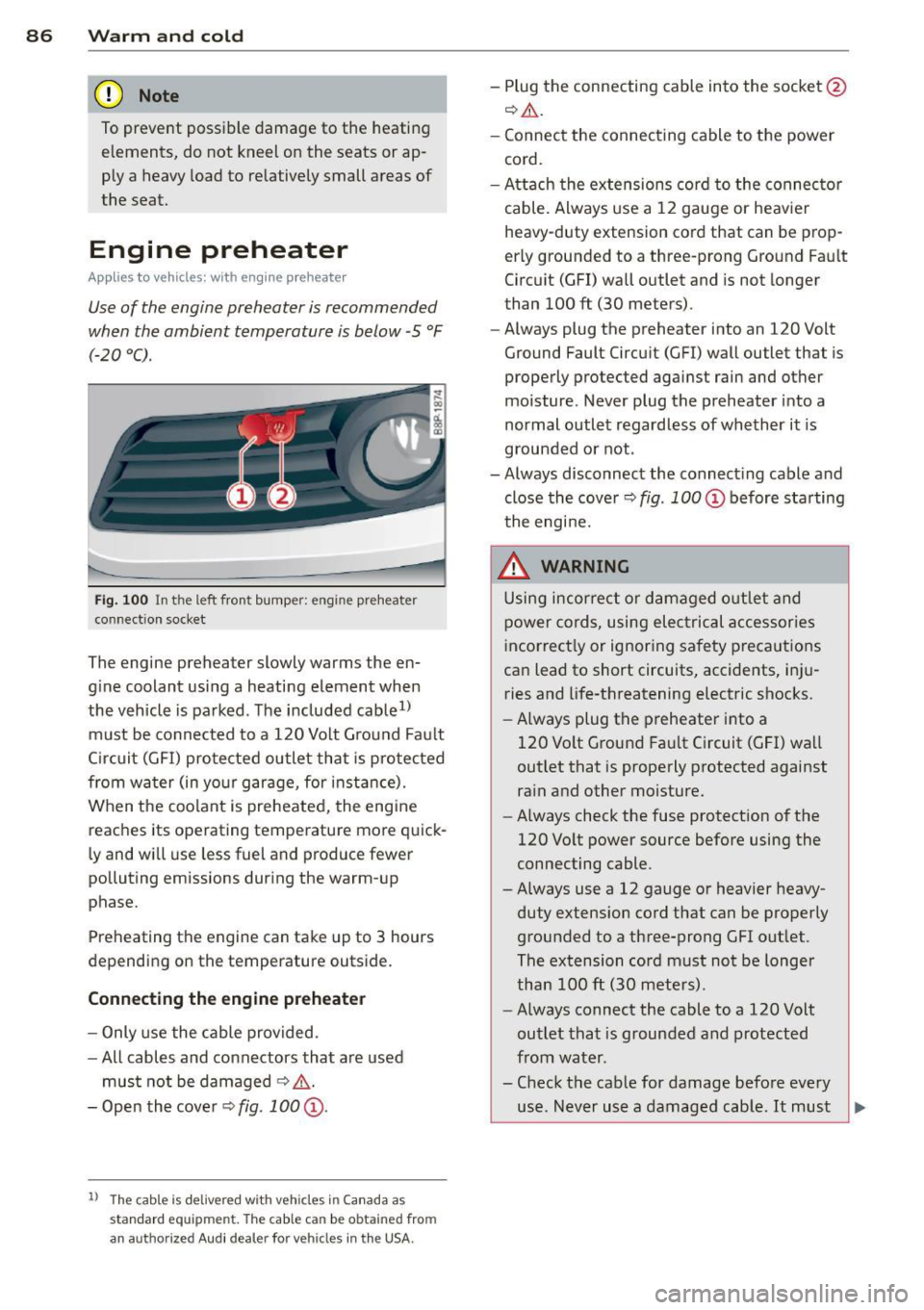
86 Warm and cold
(D Note
To prevent possible damage to the heating
elements, do not kneel on the seats or ap
ply a heavy load to relatively small areas of
the seat.
Engine preheater
Applies to vehicles: with engine p reheate r
Use of the engine pre heater is recommended
when the ambient temperature is below
-5 °F
(-20 °C) .
Fig. 100 In t he l eft fron t bump er: en gine preheater
co nn ect ion socket
The engine preheater slowly w arms the en
gine coolant using a heating element when
the vehicle is parked. The included cable
1>
must be connected to a 120 Volt Ground Fault
Circuit (GFI) protected outlet that is protected
from water (in your garage, for instance).
When the coolant is preheated, the engine
reaches its operating temperature more quick
ly and will use less fuel and produce fewer
polluting emissions during the warm-up
phase.
Preheating the engine can take up to 3 hours
depending on the temperature outside.
Connecting the engine preheater
- Only use the cable provided.
-All cables and connectors that are used
must not be damaged
¢ .&.
-Open the cover Q fig. 100 @.
l) Th e cabl e is de live red w it h veh icles i n Canada a s
s tandard e quipmen t. The cable c an be o btain ed fro m
an a uth orize d Au di d ea le r fo r veh icl es in the USA.
- Plug the connecting cable into the socket @
Q.ii_.
-Connect the connecting cable to the power
cord.
- Attach the extensions cord to the connector
cable. Always use a 12 gauge or heavier
heavy -duty extension cord that can be prop
erly grounded to a three-prong Ground Fault
Circuit (GFI) wall outlet and is not longer
than 100
ft (30 meters).
- Always plug the preheate r into an 120 Volt
Ground Fault Circuit (GFI) wall outlet that is
properly protected against rain and other
moisture. Never plug the preheater into a
normal outlet regardless of whether it is
grounded or not .
- Always disconnect the connecting cable and
close the cover
Q fig . 100 @ before starting
the engine.
_&. WARNING
-
Using incorrect or damaged outlet and
power cords, using electrical accessories
incorrectly or ignoring safety precautions
can lead to short circuits, accidents, inju ries and life-threatening electric shocks.
- Always plug the preheater into a
120 Volt Ground Fault Circuit (GFI) wall
outlet that is properly protected against
rain and other moisture.
- Always check the fuse protection of the
120 Volt power source before using the
connecting cable .
- Always use a 12 gauge or heavier heavy
duty extension cord that can be properly
grounded to a three-prong GFI outlet .
The extension cord must not be longer
than 100
ft (30 meters).
- Always connect the cable to a 120 Volt
outlet that is grounded and protected
from water .
- Check the cable for damage before every
use . Never use a damaged cable.
It must ~
Page 105 of 280
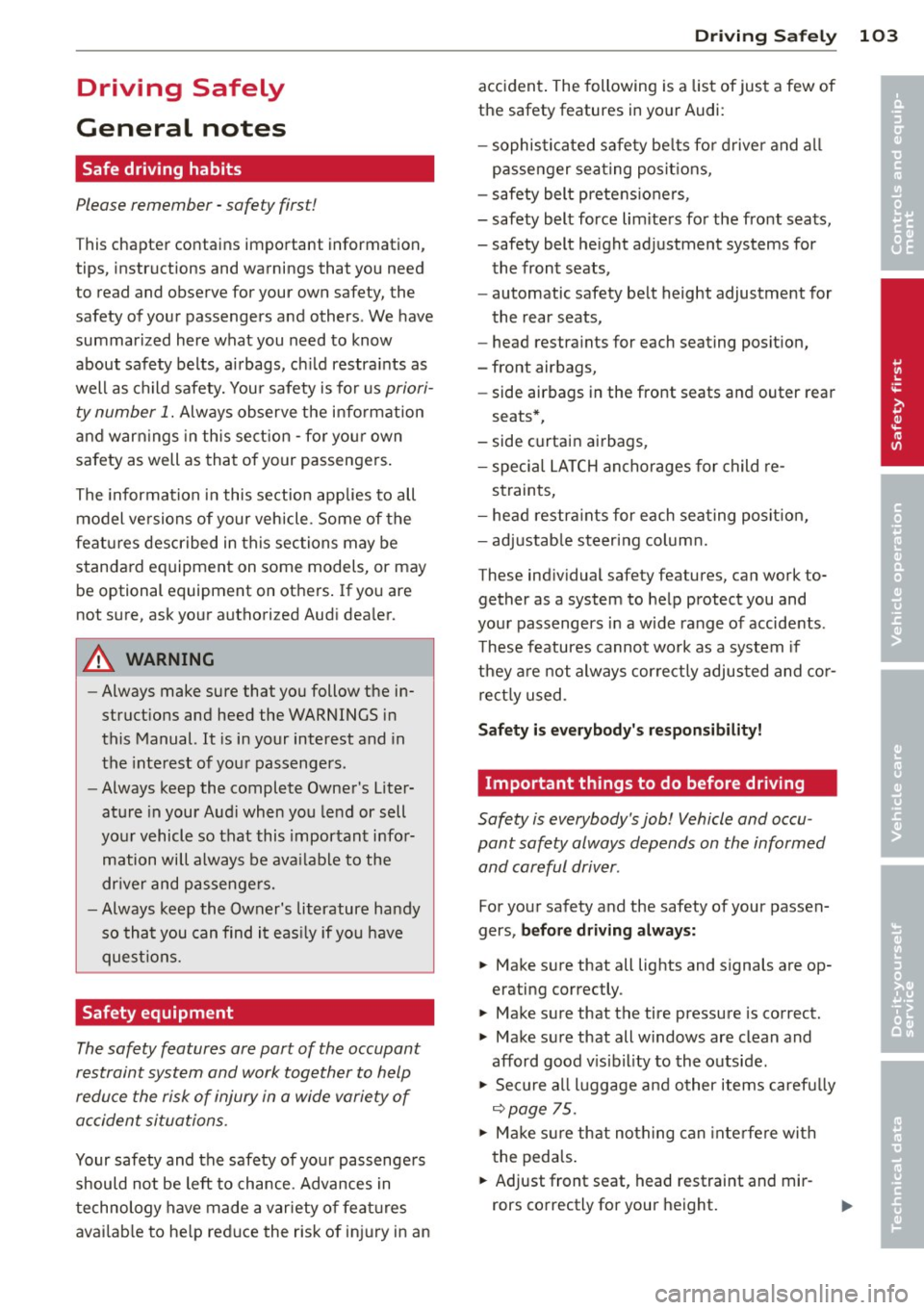
Driving Safely
General notes
Safe driving habits
Please remember -safety first!
This chapter contains important information,
tips, instructions and warnings that you need
to read and observe for your own safety, the
safety of your passengers and others . We have
summarized here what you need to know
about safety belts, airbags, ch ild restra ints as
well as child safety. You r safety is for us
priori
ty number 1.
Always observe t he information
a nd warn ings in th is se ct ion - for yo ur own
safety as well as that of your passengers .
The information in this se ction applies to all
model ve rsion s of your veh icle . Some of the
feat ures descr ibed in th is sec tions may be
standa rd equipment on some models, or may
be optional equipment on others . If you are
not sure, ask yo ur authorized Aud i dea ler.
A WARNING
- Always make sure that you follow the in
st ruct ions and heed the WARNINGS i n
this Manual. It is in your interest and in
the inte rest of you r passengers.
- Always keep the complete Owne r's Liter
at ure in your Audi when you lend or sell
yo ur vehicle so that this important info r
mation will always be ava ilable to the
dr iver and passenge rs.
- Always keep the Owner's literature handy
so that you can find i t eas ily if you have
ques tion s.
Safety equipment
The safety features are part of the occupant
restraint syst em and work togeth er to help
redu ce the risk of injury in a wide variety of
accident situations .
Your safety and the safety of your passenge rs
should not be left to chance. Advances in
t echnology have made a var iety o f fea tures
avai lable to he lp red uce the risk of i njury in an
Dr iving Safel y 103
accident . The following is a list of just a few of
the safety features in yo ur Audi :
- sophis tic ated s afety be lts fo r driver and a ll
passenger sea ting posit ions,
- s afety bel t prete nsio ners ,
- safety belt force lim ite rs fo r the front sea ts,
- safety belt he ight adjustment systems for
the front seats ,
- automatic safety be lt height adjustment for
the rear seats,
- head restra ints for each seating posit ion,
- front airbags,
- side airbags in the front seats and outer rea r
seats *,
- side c urtai n airbags ,
- specia l LATCH an cho rages for child re-
s tr ain ts,
- he ad restra ints for each sea ting posit ion,
- adj ustab le steering colum n.
These ind iv idual safety features , can work to
gether as a system to he lp protect you and
you r passengers in a w ide range of accide nts.
T hese fe;;itures c;;innot work ;;is ;;i system if
t h ey a re not always cor re ct ly adjus ted and co r
re ct ly used .
Safety is everybody' s responsibility!
Important things to do before driving
Safety is everybody 's job! Vehicle and occu
pant safety always depends on the informed
and careful driver .
For you r safety and the safety of your passen
gers,
before driving always:
.,. Make s ure that all lights and signals are op
erating correctly .
.,. Make sure that the tire pressure is correct .
.,. Make su re that all windows are clean and
afford good v isib ility to the o utside.
.,. Sec ure a ll luggage a nd other items carefu lly
~ page 75.
.,. Mak e s ure th at nothing can interfe re wi th
t he peda ls .
.,. Adjust front seat, head restraint and mir
rors co rrectly for your height.
•
•
Page 107 of 280
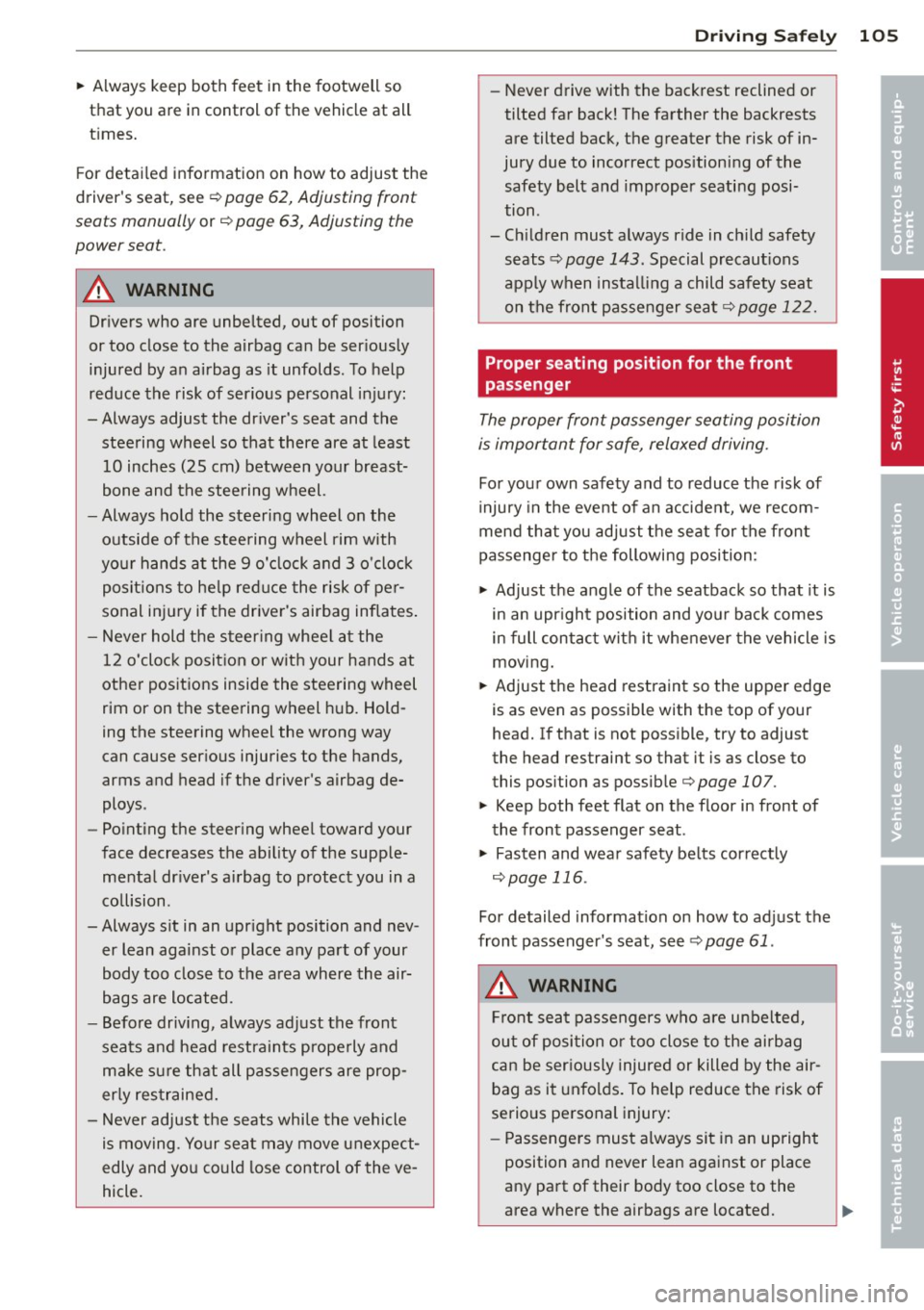
~ Always keep both feet in the footwell so
that you are in control of the vehicle at all
times.
For detailed information on how to adjust the
driver's seat, see ¢
page 62, Adjusting front
seats manually
or ¢ page 63, Adjusting the
power seat .
A WARNING
Drivers who are unbelted, out of position
or too close to the airbag can be seriously
injured by an airbag as it unfolds. To help
reduce the risk of serious personal injury:
- Always adjust the driver's seat and the
steering wheel so that there are at least
10 inches (25 cm) between your breast
bone and the steering wheel.
- Always hold the steering wheel on the
outside of the steering wheel rim with
your hands at the 9 o'clock and 3 o'clock positions to help reduce the risk of per
sonal injury if the driver's airbag inflates.
- Never hold the steering wheel at the
12 o'clock position or with your hands at
other positions inside the steering wheel
rim or on the steering wheel hub. Hold
ing the steering wheel the wrong way
can cause serious injuries to the hands,
arms and head if the driver's airbag de
ploys .
- Pointing the steering wheel toward your
face decreases the ability of the supple mental driver's airbag to protect you in a
collision .
- Always sit in an upright position and nev
er lean against or place any part of your
body too close to the area where the air
bags are located.
- Before driving, always adjust the front
seats and head restraints properly and
make sure that all passengers are prop
erly restrained.
- Never adjust the seats while the vehicle
is moving . Your seat may move unexpect
edly and you could lose control of the ve
hicle.
Driving Safely 105
- Never drive with the backrest reclined or
tilted far back! The farther the backrests
are tilted back, the greater the risk of in
jury due to incorrect positioning of the safety belt and improper seating posi
tion .
- Children must always ride in child safety
seats ¢
page 143. Special precautions
apply when installing a child safety seat
on the front passenger seat¢
page 122.
Proper seating position for the front
passenger
The proper front passenger seating position
is important for safe, relaxed driving.
For your own safety and to reduce the risk of
injury in the event of an accident, we recom
mend that you adjust the seat for the front
passenger to the following position:
~ Adjust the angle of the seatback so that it is
in an upright position and your back comes
in full contact with it whenever the vehicle is
moving.
~ Adjust the head restraint so the upper edge
is as even as possible with the top of your
head. If that is not possible, try to adjust
the head restraint so that it is as close to
this position as possible
¢page 107.
~ Keep both feet flat on the floor in front of
the front passenger seat .
~ Fasten and wear safety belts correctly
¢page 116.
For detailed information on how to adjust the
front passenger's seat, see ¢
page 61.
A WARNING
Front seat passengers who are unbelted,
out of position or too close to the airbag
can be seriously injured or killed by the air
bag as it unfolds. To help reduce the risk of
serious personal injury:
- Passengers must always sit in an upright
position and never lean against or place
any part of their body too close to the
area where the airbags are located.
-
•
•
Page 108 of 280
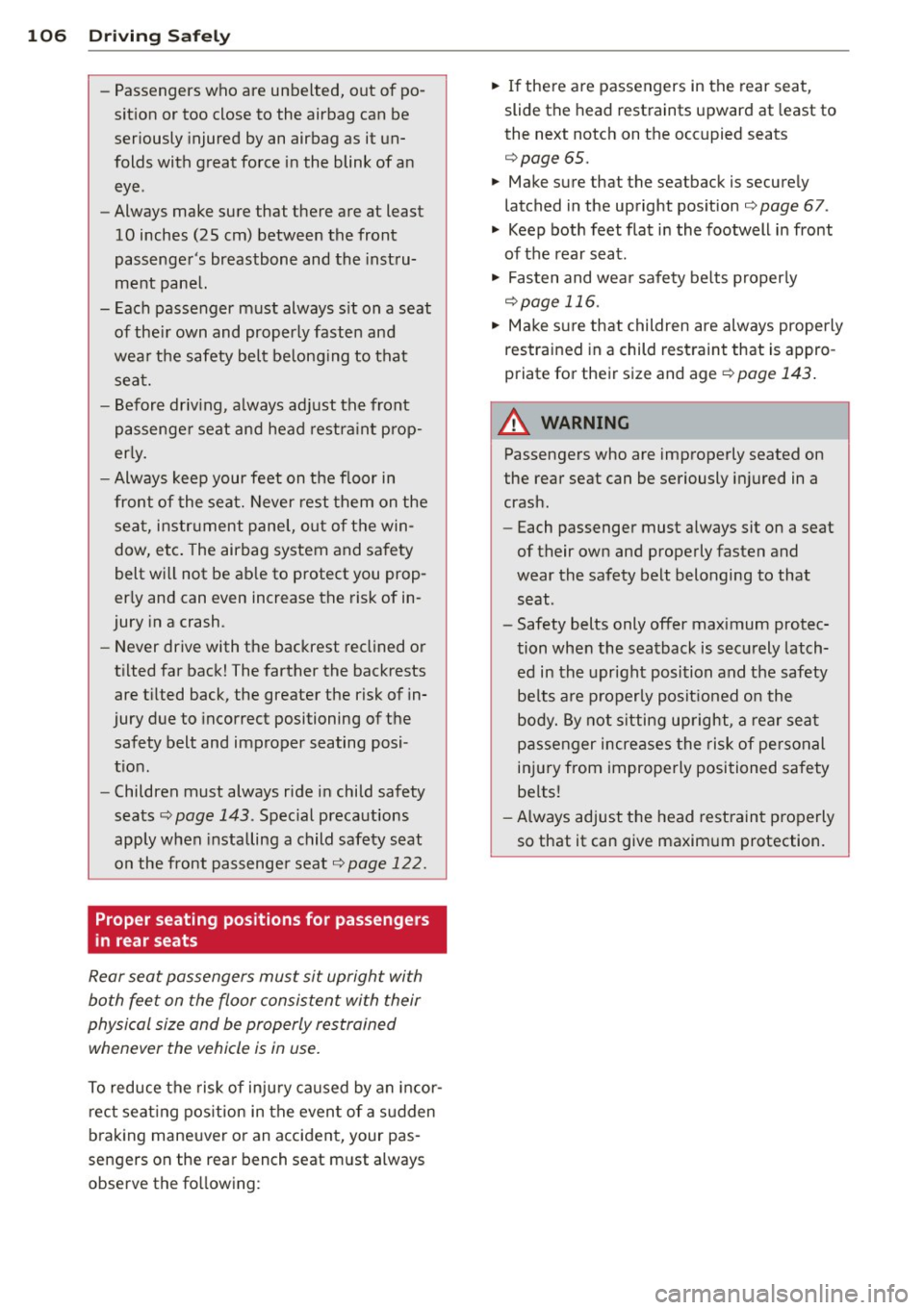
106 Driving Safely
-Passengers who are unbelted, out of po
sition or too close to the airbag can be
seriously injured by an airbag as it un
folds with great force in the blink of an
eye .
- Always make sure that there are at least
10 inches (25 cm) between the front
passenger's breastbone and the instru
ment panel.
- Each passenger must always sit on a seat of their own and properly fasten and
wear the safety belt belonging to that seat.
- Before driving, always adjust the front
passenger seat and head restraint prop
erly.
- Always keep your feet on the floor in
front of the seat. Never rest them on the
seat, instrument panel, out of the win
dow, etc. The airbag system and safety
belt will not be able to protect you prop
erly and can even increase the risk of in
jury in a crash .
- Never drive with the backrest reclined or
tilted far back! The farther the backrests
are tilted back, the greater the risk of in
jury due to incorrect positioning of the
safety belt and improper seating posi
tion.
- Children must always ride in child safety
seats ¢
page 143 . Special precautions
apply when installing a child safety seat
on the front passenger seat
c::> page 122.
Proper seating positions for passenge rs
in rear seats
Rear seat passengers must sit upright with
both feet on the floor consistent with their
physical size and be properly restrained
whenever the vehicle is in use.
To reduce the risk of injury caused by an incor
rect seating position in the event of a sudden
braking maneuver or an accident, your pas
sengers on the rear bench seat must always
observe the following :
.. If there are passengers in the rear seat,
slide the head restraints upward at least to
the next notch on the occupied seats
¢ page 65.
.. Make sure that the seatback is securely
latched in the upright position
c::> page 67 .
.. Keep both feet flat in the footwell in front
of the rear seat.
.. Fasten and wear safety belts properly
c::> page 116.
.. Make sure that children are always properly
restrained in a child restraint that is appro
priate for their size and age
c::> page 143.
A WARNING .,__
Passengers who are improperly seated on
the rear seat can be seriously injured in a
crash.
- Each passenger must always sit on a seat
of their own and properly fasten and
wear the safety belt belonging to that
seat .
- Safety belts only offer maximum protec
tion when the seatback is securely latch
ed in the upright position and the safety
belts are properly positioned on the
body. By not sitting upright, a rear seat
passenger increases the risk of personal
injury from improperly positioned safety
belts!
- Always adjust the head restraint properly
so that it can give maximum protection.
Page 109 of 280
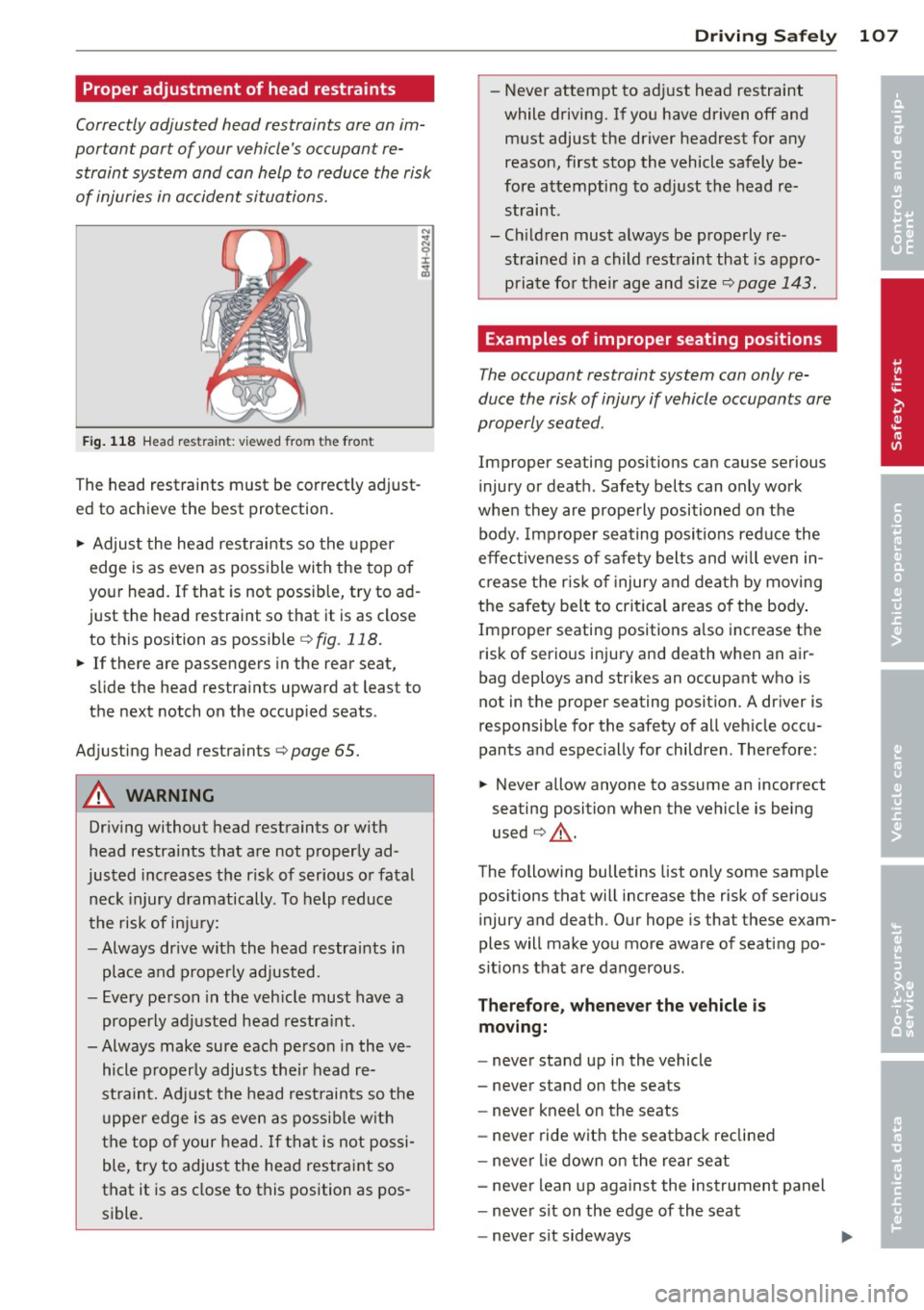
Proper adjustment of head restraints
Correctly adjusted h ead restraints are an im
portant part of your vehicle's occupant r e
straint system and can help to reduce the risk
of injuries in accident situations.
F ig. 118 Hea d re str ain t: v ie w ed fro m the front
The head restraints must be correctly adjust
ed to achieve the best protection.
,.. Adjust the head restrai nts so the upper
edge is as even as poss ible with the top of
your head. If that is not possib le, try to ad
just the head restraint so that it is as close to this position as possib le
q fig. 118.
"'" If there are passengers in the rear seat,
s li de the head restra in ts upward at least to
the next notch on the occup ied seats .
Ad justing head restraints¢
page 65.
A WARNING
Driv ing with out head restraints or w ith
head restraints that are not properly ad
justed increases the risk of serious o r fatal
neck injury d ramatically. To help reduce
the risk of inj ury:
- Always drive wit h the head restraints in
place and properly adjusted.
- Every pe rson in the veh icle must have a
properly ad justed head restra int .
- Always make sure each person in the ve
hicle p roperly adjus ts thei r head r e
st raint. Ad just t he head rest raints so t he
upper edge is as even as possi ble w it h
the top of your head. If tha t is not possi
ble, try to adjus t the head restra int so
that it is as close to this position as pos
sible.
-
Dr iving S afel y 107
-Never attempt to adj ust head restraint
while driving. I f you have driven off and
must adjust the driver headrest for any
reason, first stop the vehicle safely be
fore attempting to adjust the head re
s traint .
- Ch ild ren must a lways be properly re
s trained i n a child rest ra int that is ap pro
priate fo r their age and size ¢
page 143.
Examples of improper seating positions
The occupant restraint system can only re
duce the risk of injury if vehicle occupants are
properly seated .
Improper seating positions can cause serious
injury or death . Safety belts can only work
whe n they are properly positioned on the
body . Improper s eating positions red uce the
effectiveness of safety belts and w ill even in
c rease the r is k of i njury and dea th by mov ing
the safety be lt to crit ica l areas o f the body .
Improper seating positions a lso increase t he
risk of serio us inju ry and death when an a ir
bag deploys and str ikes an occupant who is
not in the proper seating posit ion. A dr iver is
responsible for the safety of all veh icle occu
pants a nd espec ially for children. The refo re:
"'" Never allow anyone to assume an incorrect
seating position when the vehicle is being
used ¢_&. .
The following bulletins list on ly some samp le
pos itions that will increase the risk of serio us
injury and death. Our hope is that these exam
ples will make you more aware of seating po
s itions tha t are dangerous .
Therefore, whenever the vehicle is
moving:
- neve r stand up in the vehicle
- never stand on the seats
- neve r kneel on the seats
- neve r ride wit h the seatback reclined
- never lie down o n the rear se at
- neve r lean up against the ins trumen t panel
- neve r sit on the edge of the seat
- neve r sit sideways
•
•
...
Page 115 of 280
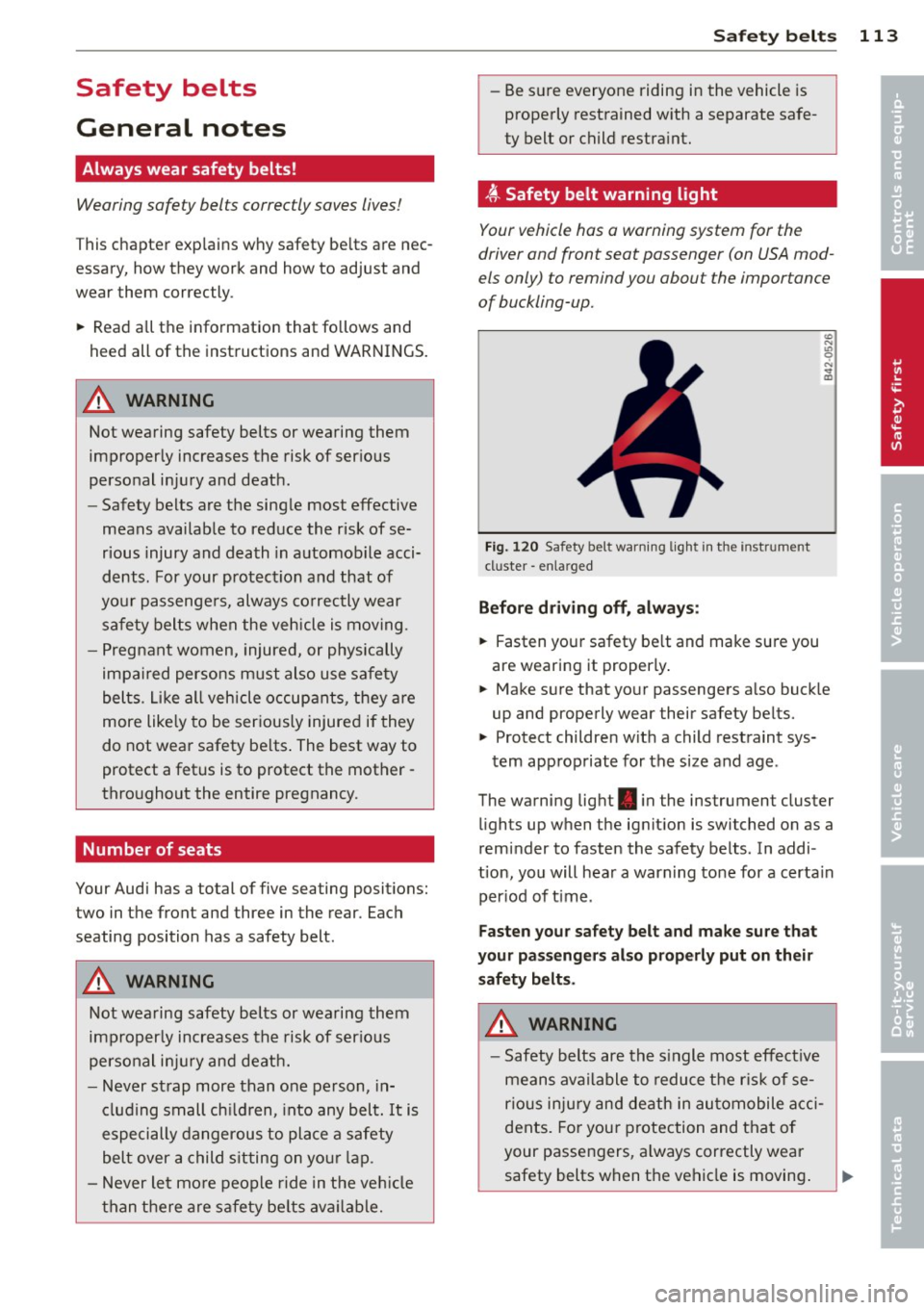
Safety belts
General notes
Always wear safety belts!
Wearing safety belts correctly saves lives!
This chapter explains why safety belts are nec
essary, how they work and how to adjust and
wear them correctly.
~ Read all the information that follows and
heed all of the instructions and WARNINGS.
A WARNING
Not wearing safety belts or wearing them
improperly increases the risk of serious
personal injury and death.
- Safety belts are the single most effective
means available to reduce the risk of se
rious injury and death in automobile acci
dents. For your protection and that of
your passengers, always correctly wear
safety belts when the vehicle is moving.
- Pregnant women, injured, or physically
impaired persons must also use safety
belts. Like all vehicle occupants, they are
more likely to be seriously injured if they
do not wear safety belts. The best way to
protect a fetus is to protect the mother -
throughout the entire pregnancy.
Number of seats
Your Audi has a total of five seating positions:
two in the front and three in the rear. Each
seating position has a safety belt.
A WARNING
Not wearing safety belts or wearing them
improperly increases the risk of serious
personal injury and death.
- Never strap more than one person, in
cluding small children, into any belt. It is
especially dangerous to place a safety
belt over a child sitting on your lap.
- Never let more people ride in the vehicle
than there are safety belts available.
Safety belts 113
-Be sure everyone riding in the vehicle is
properly restrained with a separate safe
ty belt or child restraint.
~ Safety belt warning light
Your vehicle has a warning system for the
driver and front seat passenger (on USA mod
els only) to remind you about the importance
of buckling-up.
Fig. 120 Safety belt warning light in the instr ument
cl uster -enla rged
Before driving off, always:
~ Fasten your safety belt and make sure you
are wearing it properly.
~ Make sure that your passengers also buckle
up and properly wear their safety belts.
~ Protect children with a child restraint sys-
tem appropriate for the size and age .
The warning light . in the instrument cluster
lights up when the ignition is switched on as a
reminder to fasten the safety belts. In addi
tion, you will hear a warning tone for a certain period of time .
Fasten your safety belt and make sure that
your passengers also properly put on their
safety belts.
A WARNING
- Safety belts are the single most effective
means available to reduce the risk of se
rious injury and death in automobile acci
dents. For your protection and that of
your passengers, always correctly wear
safety belts when the vehicle is moving.
•
•
Page 117 of 280
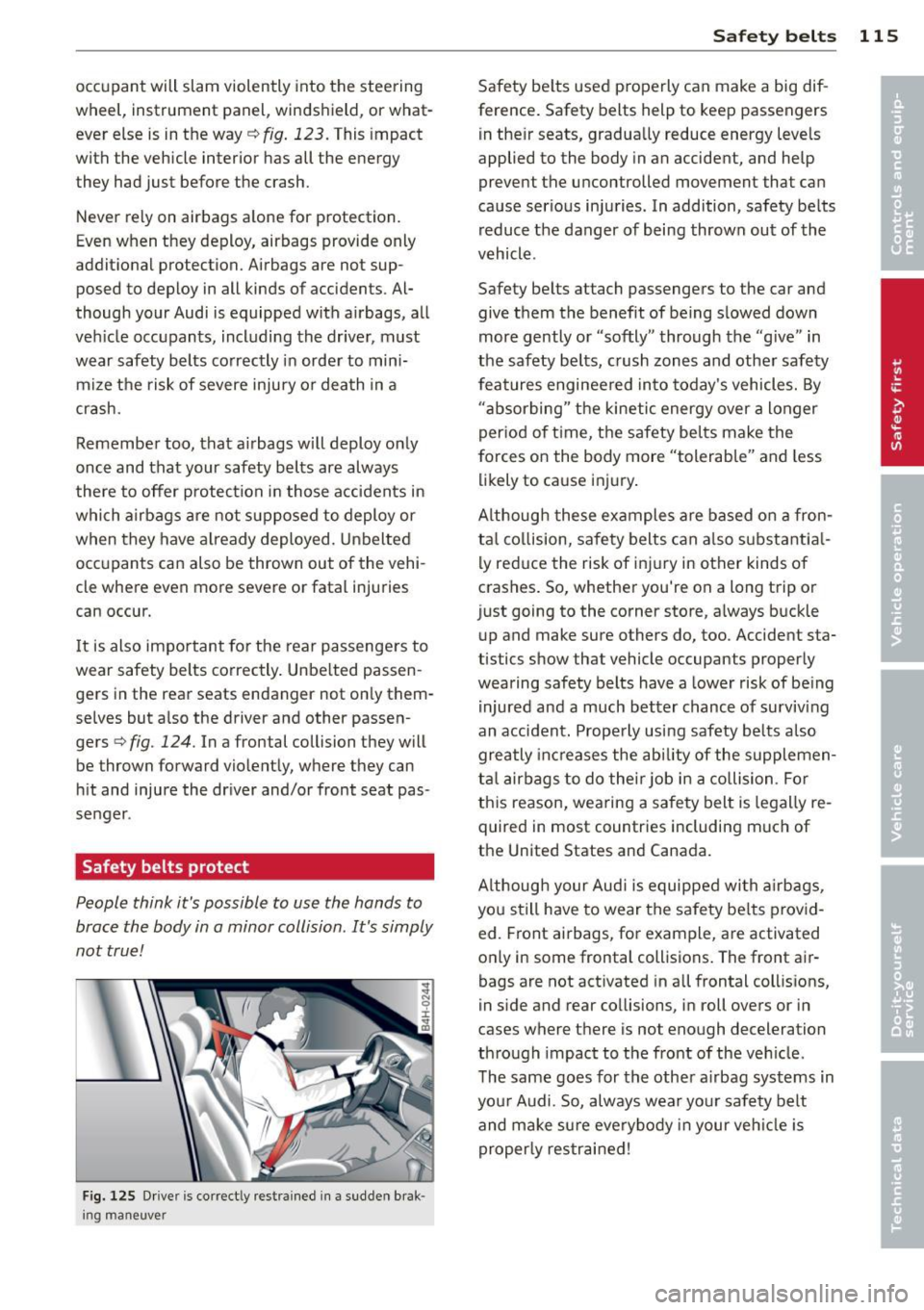
occupant will slam violently into the steering
wheel, instrument panel, windshield, or what
ever else is in the way
¢ fig. 123. This impact
with the vehicle interior has all the energy
they had just before the crash.
Never rely on airbags alone for protection.
Even when they deploy, airbags provide only
additional protection. Airbags are not sup
posed to deploy in all kinds of accidents. Al
though your Audi is equipped with airbags, all
vehicle occupants, including the driver, must
wear safety belts correctly in order to mini
mize the risk of severe injury or death in a
crash.
Remember too, that airbags will deploy only
once and that your safety belts are always
there to offer protection in those accidents in
which airbags are not supposed to deploy or
when they have already deployed. Unbelted
occupants can also be thrown out of the vehi
cle where even more severe or fatal injuries
can occur.
It is also important for the rear passengers to
wear safety belts correctly. Unbelted passen
gers in the rear seats endanger not only them
selves but also the driver and other passen
gers
r::;; fig. 124. In a frontal collision they will
be thrown forward violently, where they can
hit and injure the driver and/or front seat pas
senger.
Safety belts protect
People think it's possible to use the hands to
brace the body in a minor collision . It's simply
not true!
Fig. 125 Drive r is correct ly restrained in a sudden brak
ing maneuver
Safety belts 115
Safety belts used properly can make a big dif
ference. Safety belts help to keep passengers
in their seats, gradually reduce energy levels
applied to the body in an accident, and help
prevent the uncontrolled movement that can
cause serious injuries . In addition, safety belts
reduce the danger of being thrown out of the
vehicle .
Safety belts attach passengers to the car and
give them the benefit of being slowed down more gently or "softly" through the "give" in
the safety belts, crush zones and other safety
features engineered into today's vehicles. By
"absorbing" the kinetic energy over a longer
period of time, the safety belts make the
forces on the body more "tolerable" and less
likely to cause injury.
Although these examples are based on a fron
tal collision, safety belts can also su bsta ntia l
ly reduce the risk of injury in other kinds of
crashes. So, whether you're on a long trip or
just going to the corner store, always buckle
up and make sure others do, too. Accident sta
tistics show that vehicle occupants properly
wearing safety belts have a lower risk of being
injured and a much better chance of surviving
an accident. Properly using safety belts also
greatly increases the ability of the supplemen
tal airbags to do their job in a collision . For
this reason, wearing a safety belt is legally re
quired in most countries including much of
the United States and Canada.
Although your Audi is equipped with airbags,
you still have to wear the safety belts provid
ed. Front airbags, for example, are activated
only in some frontal collisions. The front air
bags are not activated in all frontal collisions,
in side and rear collisions, in roll overs or in
cases where there is not enough deceleration
through impact to the front of the vehicle.
The same goes for the other airbag systems in
your Audi. So, always wear your safety belt
and make sure everybody in your vehicle is
properly restrained!
Page 119 of 280
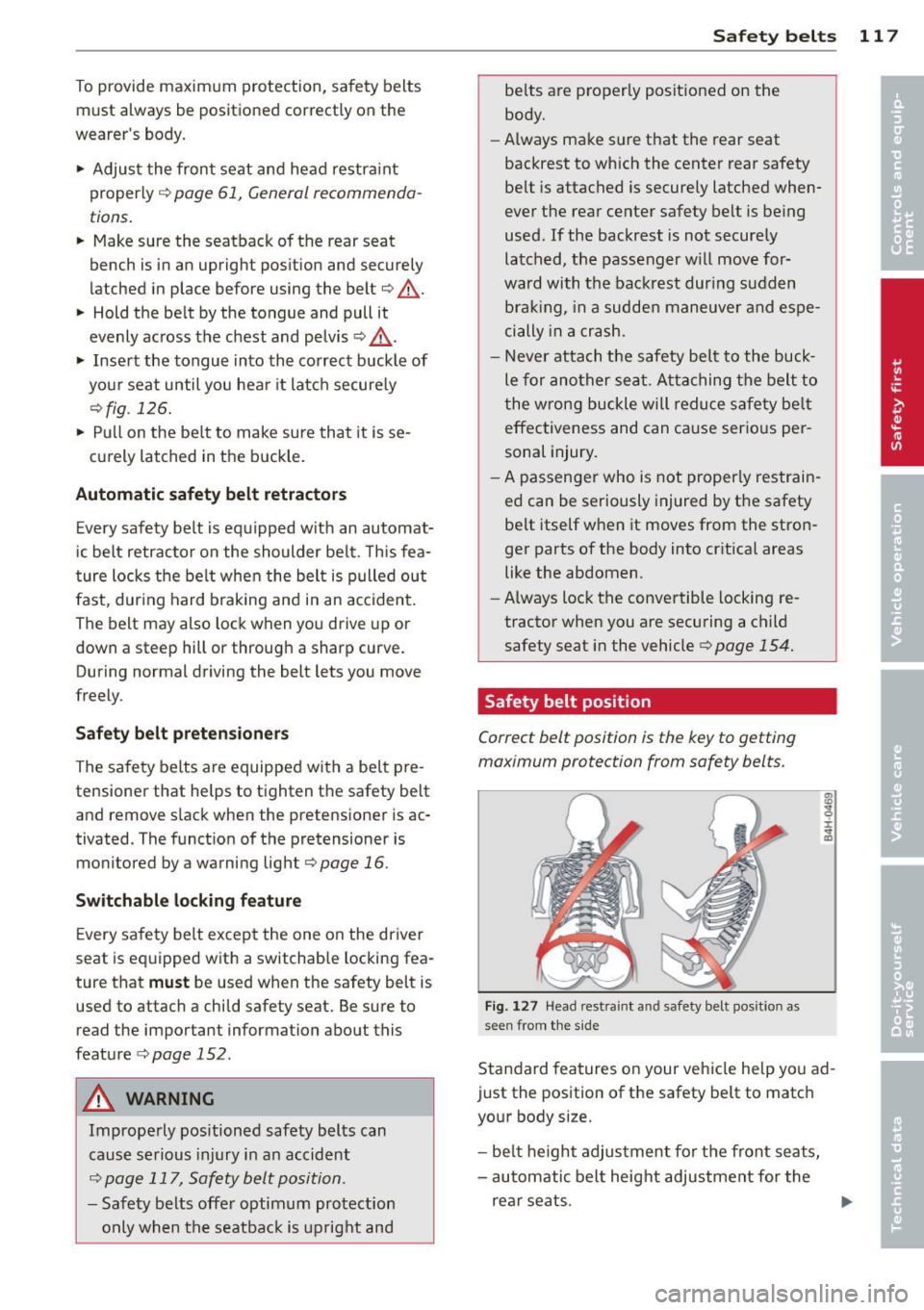
To provide maximum protection, safety belts
must always be positioned correctly on the
wearer's body .
... Adjust the front seat and head restra int
properly
c::> page 61, General recommenda
tions .
... Make sure the seatback of the rear seat
bench is in an upright position and securely
latched in place before using the belt
c::> ,&. .
... Hold the be lt by the tongue and pull it
evenly across the chest and pelvis
c::> ,&..
... Insert the tongue into the correct buckle of
your seat until you hea r it latch securely
c::> fig. 126.
... Pull on t he be lt to make sure that it is se-
curely latched in the buckle.
Automatic safety belt retractors
Every safety belt is equipped w ith an automat
i c belt retractor on the shoulder be lt. This fea
ture locks the be lt when the belt is pulled out
fast, dur ing hard braking and in an accident.
The belt may also lock when you drive up or
down a steep hill or through a sharp curve.
During normal driving the belt lets you move
freely.
Safety belt pretensioners
The safety belts are equipped with a belt pre
tensioner that helps to tighten the safety belt
and remove slack when the pretensioner is ac
tivated. The funct ion of the pretensioner is
monitored by a warning light
c::> page 16.
Sw itchable locking feature
E very safety belt except the one on the driver
seat is equipped with a switchable locking fea
ture that
must be used when the safety belt is
used to attach a child safety seat. Be sure to read the important information about this
feature
c::> page 152.
A WARNING
Imprope rly positioned safety belts can
cause serious injury in an accident
o::> page 117, Safety belt position.
-Safety belts offer optimum protect ion
only when the seatback is upright and
Safety belts 11 7
belts are properly positioned on the
body.
- Always make sure that the rear seat
backrest to which the center rear safety
be lt is attached is securely latched when
ever the rear center safety belt is being
used. If the backrest is not securely latched, the passenger w ill move for
ward with the backrest during sudden
braking, in a sudden maneuver and espe
cially in a crash .
- Never attach th e safety belt to the buck
le for another seat . Atta ching the belt to
the wrong buckle will reduce safety be lt
effectiveness and can cause ser ious per
sonal injury.
- A passenger who is not proper ly restrain
ed can be seriously injured by the safety
be lt itself when it moves from the stron
ger parts of the body into critical areas
like the abdomen.
- Always lock the convertible locking re
tractor when you are securing a child safety seat in the vehicle
c::> page 154.
Safety belt position
Correct belt position is the key to getting
maximum protection from safety belts.
Fig . 1 27 Head restra int and safety belt pos it ion as
see n from the s ide
ill
q :r ... CD
Standard features on your vehicle he lp you ad
just the position of the safety belt to match
your body size.
- be lt h eight adjustment for the front seats,
- automatic belt height adjustment for the
rear seats .
Page 121 of 280
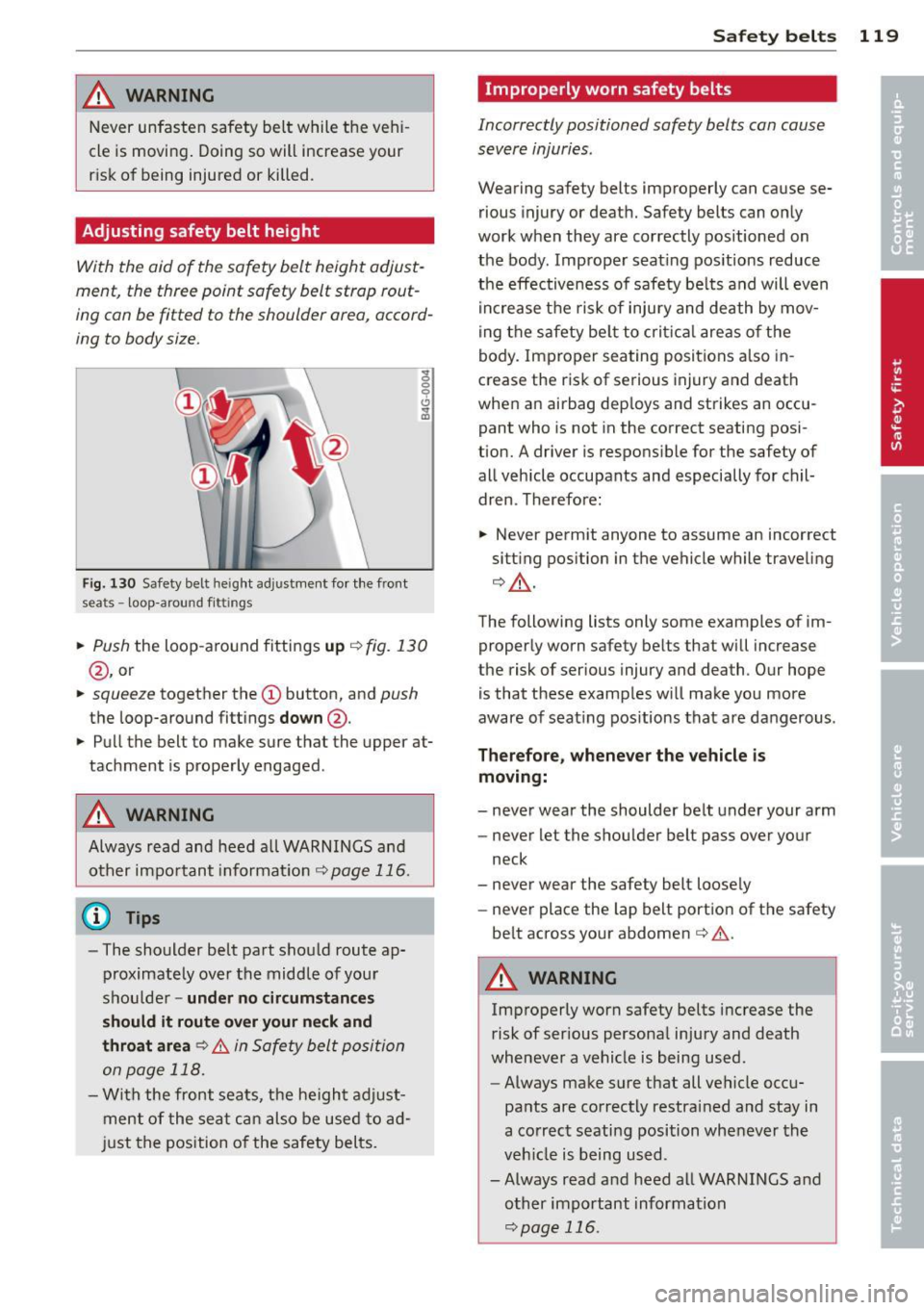
,&_ WARNING
Never unfasten safety belt while the vehi
cle is movi ng . Doing so will increase your
risk of being injured or killed .
Adjusting safety belt height
With the aid of the safety belt height adjust
ment, the thr ee point safety belt strap rout
ing can be fitted to the shoulder area, accord
ing to body size.
Fi g. 13 0 Safety be lt heig ht ad justment fo r the fr ont
s e ats - loop -a ro un d f ittin gs
g 0 0 0 ... a,
• Push the loop -aro und fitti ngs up ¢ fig. 130
@ , or
• squee ze together the (D button, and push
the loop-around fitt ings down @.
• Pull the belt to make sure that the upper at
tachment is properly engaged .
_&. WARNING
Always read and heed all WARNINGS an d
ot her i mpo rtant in format io n
¢ page 116.
(D Tips
-The sho ulder belt part sho uld route ap
pro ximately over the middle of your
shou lde r -
under no circum stances
should it route over your neck and
throat area
¢ .&. in Safety belt posi tion
on page 118.
- Wi th the fr ont seats, the he igh t adju st
me nt of the se at c an a lso be used to ad
ju st the position o f the safety belts.
Safety belts 119
Improperly worn safety belts
Incorrectly positioned safety belts can cause
severe injuries .
Wearing safety belts improperly can cause se
rious injury or death. Safety belts can on ly
work when they are correctly positioned on
the body . Imprope r seat ing pos itions reduce
the effectiveness of safety be lts and will
even
inc rea se t he risk of inju ry and death by mov
in g t he safety be lt to c riti cal a reas o f the
bo dy. Improper seating posi tions a lso in
c rease the ris k of serious injury and death
when a n airbag dep loys and strikes an occu
pant who is not in the correct seating posi
tion. A driver is respons ible for the safety of
all vehicle occupants and especially for ch il
dren . Therefore:
• Never perm it anyone to assume an incorrect
sitt ing pos ition in the vehicle while traveling
¢ _& .
The following lists only some examples of im
proper ly worn safety belts that will increase
the risk of ser ious injury and death . Our hope
is that these examp les w ill make you more
aware of seat ing pos itions that are dangerous .
Therefore, whenever the vehicle is
moving:
- never wear the shoulder belt under your arm
- never let the s hou lder belt pass over yo ur
neck
- never wear the safety belt loose ly
- neve r place the lap belt port ion of the safety
be lt across your abdomen¢.&. .
_&. WARNING
Im properly worn safety belts increase the
risk of ser ious persona l injury and death
whenever a vehicle is being used .
- Always make s ure t hat all vehicle occu
pa nts are co rrectly restra ined and stay in
a co rrect seati ng position whe never th e
veh icle is being used.
- A lways read and heed a ll WARNIN GS and
o th er impo rtant information
¢ pag e 116 .
Page 125 of 280
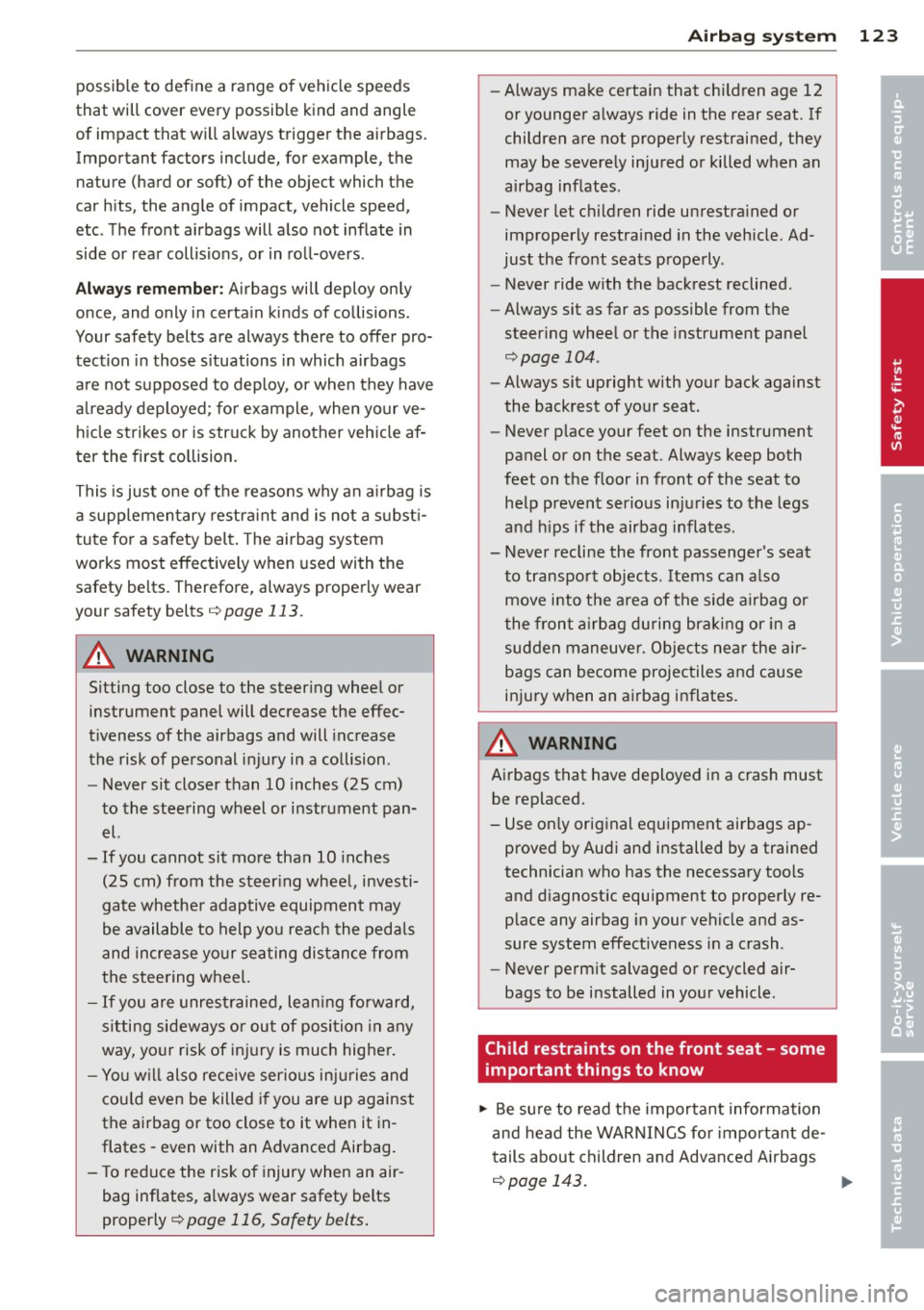
possible to define a range of vehicle spee ds
that will cover every possible kind and angle
of impact that will always trigger the a irbags .
Important fact ors include, for example, the
nature (hard or soft) of the object which the
car hits, the angle of impact, vehicle speed,
etc. The front airbags will also not inflate in
side or rear collisions, or in ro ll-overs .
Alw ay s rem ember : Airbags will deploy only
once, and only in certa in kinds of collisions .
Your safety belts are always there to offer pro
tection in those s ituation s in which airbags
are not supposed to deploy , or when they have
a lready deployed ; fo r example , when yo ur ve
h icle strikes or is struck by another veh icle af
ter the first co llision.
This is just one of the reasons why an a irbag is
a supplementary restra int and is not a s ubst i
tute for a safety belt . The airbag system
works most effectively when used with the
safety belts. Therefore, always properly wear
your safety belts¢
page 113 .
A WARNING
Sitting too close to the steer ing wheel or
instrument panel will decrease the effec
tiveness of the airbags and will increase
the risk of personal injury in a co llision .
- Never sit closer than
10 inches (25 cm)
to the steering wheel or instrument pan el.
- If you cannot sit more than
10 i nches
(25 cm) from the steer ing wheel, investi
gate whether adaptive equipment may
be available to help you reach the pedals
and increase your seating dis tance from
the steering wheel.
- If you are unrestrained, lean ing fo rward,
sitting sideways or out of position in any
way, yo ur risk of inj ury is much highe r.
- You w il l also receive serio us injuries and
cou ld even be killed if you are up against
the airbag or too close to it when it in
flates -even with an Advanced Airbag.
- To reduce the r isk of injury when an air
bag inflates, a lways wear safety belts
properly ¢
page 116, Safety belts .
Airbag system 123
-Always make certain that chi ld ren age 12
or younger a lways ride in the rear seat. If
children are not properly restrained, they may be severe ly inju red or killed when an
airbag inf lates .
- Never let ch ildren ride unrestra ined or
improperly restrained in the vehicle . Ad
just the front seats prope rly .
- Never ride with the backrest reclined.
- Always sit as far as possible from the
steer ing whee l or the instrument pane l
¢page 104.
-Always sit upright with your back against
the backrest of your seat.
- Never p lace your feet on the instrument
panel or on the seat. Always keep both
feet on the f loor in front of the seat to
he lp prevent serio us in ju ries to the legs
and h ips if the airbag inflates.
- Never recline the front passenger 's seat
to transport objects. Items can a lso
move into the area of the s ide a irbag or
the front a irbag du ring bra king or in a
sudde n maneuve r. Obje cts ne ar the air
bags can become projectiles and cause
injury when an airbag inflates.
_&. WARNING ~
A irbags that have de ployed in a crash must
be replaced.
- Use on ly original equipment airbags ap
proved by Audi and installed by a trained
technician who has the necessary too ls
and d iagnost ic equipment to properly re
place any airbag in your vehicle and as
sure system effectiveness in a crash .
- Never perm it salvaged or recycled air
bags to be installed in your vehicle .
Child restraints on the front seat - some
important things to know
.,. Be su re to read t he important information
a nd head the WAR NINGS fo r important de
t ails about children and Advanced A irbags
¢ page 143. ..,.
•
•